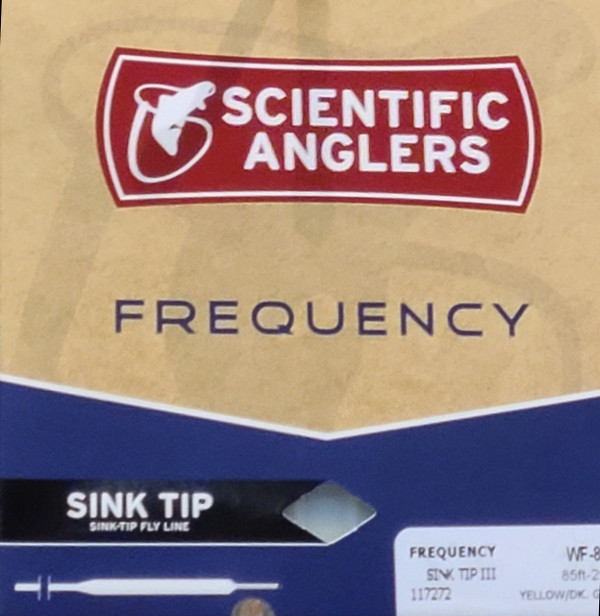Fly line selection is the most important part of any fly fishing setup. Fishing for smallmouth bass on the fly is not different. Smallmouth take a wide variety of flies in a wide variety of presentations, so you want a versatile line.
Smallies are typically found in more temperate water than most trout water, so a cold water line usually isn’t ideal unless you’re targeting them exclusively in the colder months of the year. At the same time, a full tropical line is typically geared towards warmer climates than smallmouth bass occupies, and will no perform well in the spring and fall. For these reasons, you want a fly line that is rated for moderate temperatures.
Smallmouth bass flies are also larger than many trout flies. You’ll want a line that has the heft necessary to deliver these bigger flies to their target.
Listed below are some of the lines that check all the right boxes for being a great smallmouth bass fly line.
Sink Tip Fly Line – Scientific Anglers Frequency Sink Tip

A sink tip line is by far my most used line when targeting smallmouth bass. It’s especially effective in moving water.
This line is particularly good when wading for smallmouth in rivers. The sink tip allows streamers to get down into the strike zone quickly. Deeper slack water pockets and strong current require more than just a weighted fly on a floating line to get down.
The floating running line portion of this fly line makes line management much easier than a full sink line. A full sink line would require a stripping basket, otherwise, the line will get tangled around your feet and rocks while fishing. Sink tip lines don’t run into this issue, as the excess line stays floating on top of the water during your strip retrieve.
This line comes in a few different sizes as indicated below (credit to Scientific Anglers site). I personally use the 7 weight option and find it ideal for not only smallmouth but walleye as well.
A 6 weight to 8 weight would be ideal for bass. Specific weight is really up to your preference. I would go with 6 or 7 weight if the water holds smallies and trout, while I’d go with the 7 or 8 weight if you’ll be fishing water with both smallmouth and largemouth bass.
Fly line size suggestion is based on fly size you’ll be throwing, not necessarily the size of the fish. If you’re specifically chasing largemouth though, use a line with a bit of a heavier taper to help turn over the larger flies.
You can buy Scientific Anglers WF-7-S Type Frequency Sink Tip Line (Amazon Link) here.
| LINE WEIGHT | HEAD LENGTH | TOTAL LENGTH | GRAIN WEIGHT* |
| WF-5-F/S | 45.0’ / 13,7m | 85.0’ / 25,9m | 140gr / 9,1g |
| WF-6-F/S | 45.0’ / 13,7m | 85.0’ / 25,9m | 160gr / 10,4g |
| WF-7-F/S | 45.0’ / 13,7m | 85.0’ / 25,9m | 185gr / 11,9g |
| WF-8-F/S | 45.0’ / 13,7m | 85.0’ / 25,9m | 210gr / 13,6g |
A few suggestions on smallmouth bass flies to use with a sink tip line are:
- Woolly buggers
- Deceivers
- Slumbusters
- Crayfish Patterns
“RIO’s Big Nasty” is another great option for a smallmouth bass sink tip line. The only caveat is that it will not perform as well in warmer conditions as the Scientific Anglers sink tip listed above. It’s an excellent option for targeting smallmouth in cooler rivers though.
Floating Lines – Rio Specialty Series Smallmouth Bass Floating Line

If you’re only getting a single line, then a floating fly line is the most versatile. You can fish all the typically topwater flies, and use heavier streamers to fish subsurface. You can even nymph for bass successfully with a floating line.
This is a specialty line designed by RIO to specifically address the needs of smallmouth bass fly fishing. It’s weighted so that it can easily cast beefy deer hair bass bugs and weighted clousers. Additionally, it was designed to be fished in the heat of the summer, which when targeting smallies on topwater is the most productive.
This line comes in three different sizes. 6, 7, and 8 weight. It depends on the size flies that you’re throwing, but I personally find a 7 weight is a good standard fly line size for most smallmouth bass fishing.
If you’re planning on fishing lakes with Largemouth, considering bumping that to an 8 weight to handle the larger frog and popper patterns typically used to target largemouth bass.
If the water you’re fishing has a mix of trout and smallies, a 6 or 7 weight it probably a better choice.
RIO Fly Line Smallmouth Bass (Amazon Link)
A few suggestions on smallmouth bass flies to use with this line are:
- Hopper Patterns
- Gurglers
- Poppers
- Dahlberg Divers
- Dragonfly Patterns
- Mouse Patterns
Full Sinking Line
Full sinking lines have their place when targeting smallmouth as well. They’re generally most effective targeting fish holding deep in still water situations, such as lakes.
You can use a full sinking line when wading, but it requires a stripping basket. Some folks are fine with this, but it is a bit more cumbersome than fishing without. If you’re stationary (such as fishing from a boat), a stripping basket is less of a liability.
A full sink line is generally paired with unweighted (or even slightly buoyant) flies. Allowing the fly line to do the work of sinking the fly, allows you to use unweighted flies with better action. Flies with big deer hair heads are particularly effective, as they keep the fly up and off the bottom, even if the sink tip is quite close to the bottom.
Forage in a lake also tends to be bigger than forage in a river, so bigger flies also match the hatch better in still water environments that you would use a full sink line in.
I’m a big fan of the Scientific Anglers Sonar Titan Hover/Sink 2 / Sink 4 Fly Line Wf7S (Amazon Link) (or SONAR TITAN INT / SINK 3 / SINK 5 if you need it to get even deeper), which I use in a larger size (10WT) for pike and musky fly fishing. Much like my previous recommendations, I’d recommend a 6-8 weight when chasing bass.
I suggested fly recommendations for each of the lines above, but didn’t go into fly selection in much detail. If you want even more fly suggestions for smallmouth bass. Check this page out for a more complete list of the most productive smallmouth bass flies.

2 thoughts on “3 Effective Smallmouth Bass Fly Lines”